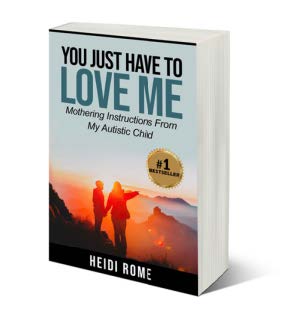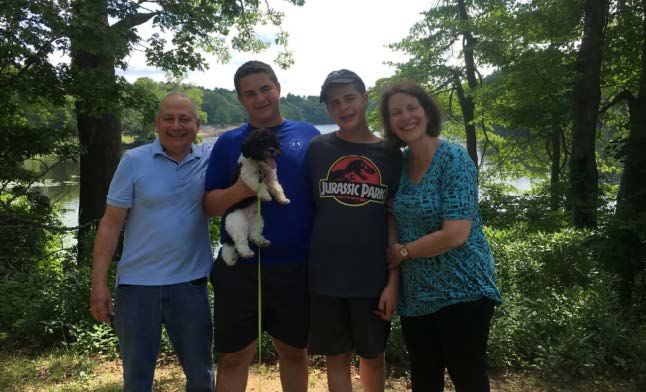"Being the mom of an autistic child of any age is tough. We worry so much about what to DO that we forget the real question is who we parents need to BE on the autism journey. I share the life-changing conversation I had with my nonverbal, autistic child that showed me my true role as his mom and guide. "You just have to love me" is from a direct conversation with my nonverbal son Ethan."
YOU JUST HAVE TO LOVE ME: Mothering Instructions from My Autistic Child
REVIEWED BY LAUREN AGORATUS M.A.

- Title: You Just Have to Love Me: Mothering Instructions From My Autistic Child
- Author: Heidi Rome
- Publisher: Independently published
- Publication Date: May 8, 2020
- Paperback: 156 pages
- ISBN-13: 979-8609882097
- Available at Amazon.com
Chapter 1: In the Beginning
The first chapter is introductory, where we meet the author's son Ethan. The author explains that once she accepted that her child wasn't "typical" she "began to see another path and a positive future for my family…A less-traveled trail, an alternative route based on love instead of fear," which is the whole point of the book.
The tone of the book is casual, so it's almost like having a conversation. One of the key tenets of the book is Ethan's mother's realization that her role "was not to improve or change him, but to be his champion and a support system for him as he was in full love and acceptance, unconditionally."
Later, his parents had to make the difficult decision of residential placement, which the AAP (American Academy of Pediatrics) recognizes as the last resort.1 (It was unclear why Ethan's current method of communication would be unavailable in the new setting and how he would then communicate.) Fortunately, (Chap. 8) Ethan later communicated he was happy and "I want to stay here."
Using Facilitated Communication (FC), Ethan was able to give his parents life-changing advice. He stated, "You just have to love me and that is your job. The rest is my job to do." Hence the book title. The author stresses neurodiversity. She doesn't search for a "cure" but thinks that "Our message to all our children, spoken and unspoken, differently wired or neurotypical, must be one of love, joy, and acceptance."
Chapter 2: Loving Connection is Everything
The author had high hopes for ABA (Applied Behavioral Analysis), but it didn't work for Ethan. They then tried DIR (Developmental, Individual Difference, and Relationship-Based Model) Floortime and had better outcomes. She mentions the "constraint methods" used and it is unclear if this means restraints, which are ineffective as behavior modification and experienced as trauma. Nevertheless, the focus then became on why challenging behaviors were occurring. She explains parental guilt and shame "about all we had not known before we did know it" or as other families have said, "You don't know what you don't know."
Chapter 3: Life is Beautiful when People Understand You
Using FC, Ethan's parents found that they had underestimated him. Others have made the same mistake and realize that just because someone can't talk doesn't mean they have nothing to say. They decided to try to ask Ethan about composing poetry and were surprised to find out he already did.
Chapter 4: The Autism Hope Mindset Step 1: Honor your Grieving Process
Self-care for parents is discussed. First, it is asked "What kind words would you say to a good friend who has suffered a loss of any kind?" The author notes that "strangers and other people you might not have thought of will step up" and she started to notice "all kinds of everyday miracles."
Chapter 5: The Autism Hope Mindset Step 2: Embrace your Expertise and your Mom Instinct
Recognize that "You are the best expert about your child." Parents are the best-case manager as they have a vested interest. For overwhelmed parents, she suggests, "Just do your best and trust yourself and your instincts! That is perfect and that is enough." You are enough. But also remember that "Every human being – yes, including your autistic child – has their own soul, their own consciousness, their own free will. She offers an experiment when a child acts out to "change what you say to him and to yourself" (I won't give it away). Most importantly, "presume competence" and assume "your child understands every word you and others say."
Chapter 6: The Autism Hope Mindset Step 3: Avoid the Pitfalls of Autism
It is essential to "Distinguish between factual circumstances and you own emotional response to those circumstances." Also recognize that while all this learning and therapies may be good for your child, that they may act out or, as Ethan stated, simply through FC, "I am tired." Again, self-care is also stressed for parents.
Chapter 7: The Autism Hope Mindset Step 4: Accept What Is
The most important point in this chapter is that acceptance doesn’t mean giving up.
Chapter 8: The Autism Hope Mindset Step 5: Prepare for every Step with Purpose, Poise, and Practicality
Look at what your child needs right now. Even mistakes can be opportunities to learn. "Trust that whoever is needed will show up and that whatever is needed will be revealed." An example in this reviewer's life was when she just hired an in-home day care worker and the early intervention program decided to start ASL (American Sign Language), that worker already knew it; another example was the next day care worker was a speech therapist from an autism school, even before she knew her daughter had autism.
The author describes balance and prioritizing over background noise. She suggests support groups; this reviewer also recommends Parent-to-Parent.2 The author discusses guardianship and wills; this reviewer also reminds readers of Supported Decision-Making3 to retain the individual's rights. She also recommends to "Familiarize yourself… with your child's condition" to not feel so helpless or hopeless. The author also warns against "dozens of compelling (and costly) options." She recommends learning from others and advocating; this reviewer recommends PTIs (parent training and information centers).4
Chapter 9: The Autism Hope Mindset Step 6: Love Yourself to Love your Autistic Child
Here the author delves into spirituality. She also discusses systemic advocacy and that "Helping any one of us helps all of us," rather than individual families having to fight the same battles.

NEW PATHS: The author with (from left) her husband Steve and sons Eric and Ethan; "Every human being — yes, including your autistic child — has their own soul, their own consciousness, their own free will."
Chapter 10: The Autism Hope Mindset Step 7: Plug into the Spiritual Power Grid
This goes beyond religion. The author also notes, "Ethan has given… permission to tell his story." She notices "patterns in your life that aren't just random coincidences." The author notes that autism caregiving can be lifelong for parents, and beyond.
Chapter 2: Autism as a Spiritual Path
Although autism mothers are mentioned, one is left wondering about the role of fathers. The spiritual path is different for each reader. The author notes the distinction between helping and enabling, between "relationship and enmeshment", and allowing the dignity of risk.
Throughout, the author doesn't just give advice, but also provides concrete examples on the "how." A good book leaves readers wanting more. The only thing missing was that this reviewer wanted to hear more of Ethan's advice to parents of children on the spectrum.•
ABOUT THE REVIWER:
Lauren Agoratus, M.A. is the parent of a young adult with autism and medical complexity. She serves as the State Coordinator for Family Voices-NJ and as the central coordinator in her state's Family-to-Family Health Information Center. FVNJ and F2FHIC are both housed at the SPAN Parent Advocacy Network (SPAN) at spanadvocacy.org.
References